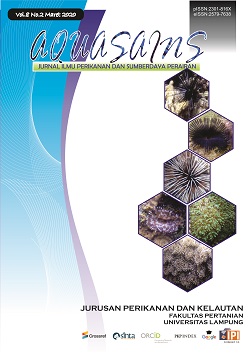IMPROVEMENT IN THE GROWTH PERFORMANCE OF TIGER GROUPER Epinephelus fuscoguttatus (Forsskal, 1775) BY PROBIOTIC MICROCAPSULES, Bacillus sp. D2.2
DOI:
https://doi.org/10.23960/aqs.v8i2.p853-860 Abstract View: 744
Abstract View: 744
Abstract
Probiotics in the fish's body are able to optimize the nutrition of feed given for growth. Microcapsule techniques can protect probiotics as they pass through the digestive tract. This study aims to study the increase in growth of tiger grouper fish fed with probiotic Bacillus sp. Microcapsules. D2.2 with different dosages. The study was conducted in May - June (30 days) with 5 treatments and 3 replications. The treatments applied are K- (feed without probiotics), K + (feed + liquid probiotics), A (feed + probiotic microcapsules 1 gram / kg of feed), B (feed + probiotic microcapsules 2 gram / kg of feed), C (feed + probiotic microcapsules 3 grams / kg of feed). The following are the highest observations, namely absolute weight gain (23.8 ± 0.7) grams, specific growth rate (1.35 ± 0.04)% /day, feed covertion ratio (FCR) (1.3 ± 0.1) ), survival rate (83 ± 2.9)% and protein digestibility 90.56% while the lowest value is in the control treatment. The results showed that the administration of probiotic microcapsules was able to significantly increase the growth of tiger grouper fish compared to control treatments.Downloads
Download data is not yet available.
Downloads
Published
2020-04-30
How to Cite
Setyabudi, I. S., Harpeni, E., & Wardiyanto, W. (2020). IMPROVEMENT IN THE GROWTH PERFORMANCE OF TIGER GROUPER Epinephelus fuscoguttatus (Forsskal, 1775) BY PROBIOTIC MICROCAPSULES, Bacillus sp. D2.2. Aqusains: Jurnal Ilmu Perikanan Dan Sumberdaya Perairan, 8(2), 853–860. https://doi.org/10.23960/aqs.v8i2.p853-860
Issue
Section
Articles

.png)










